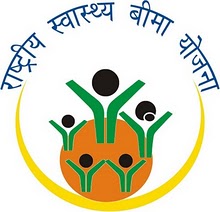"National Health Insurance Programme"
: राष्ट्रीय स्वास्थ्य बीमा योजना)
is a government-run health insurance scheme for the Indian poor. It provides for cashless insurance for hospitalisation in public as well private hospitals. The scheme started enrolling on April 1, 2008 and has been implemented in 25 states of India. A total of 23 million families have been enrolled as of February 2011.
Every "below poverty line" (BPL) family holding a yellow ration card pays  30 (less than US$0.7) registration fee to get a biometric-enabled smart card containing their fingerprints and photographs. This enables them to receive inpatient medical care of up to
30 (less than US$0.7) registration fee to get a biometric-enabled smart card containing their fingerprints and photographs. This enables them to receive inpatient medical care of up to  30,000 (approx US$670 as of March 2011) per family per year in any of the empanelled hospitals. Pre-existing illnesses are covered from day one, for head of household, spouse and up to three dependent children or parents.
30,000 (approx US$670 as of March 2011) per family per year in any of the empanelled hospitals. Pre-existing illnesses are covered from day one, for head of household, spouse and up to three dependent children or parents.
The scheme is run on shared financial contribution by both central and state governments: 75% of the  600 (approx US$13) premium (per person per year) is borne by the central government, and the rest by the state governments. There is profit motive for all parties involved. Private insurance companies provide the risk coverage, while private third-party administrators empanel hospitals and manage claims. Fixed rates have been prescribed for a long list of interventions.
600 (approx US$13) premium (per person per year) is borne by the central government, and the rest by the state governments. There is profit motive for all parties involved. Private insurance companies provide the risk coverage, while private third-party administrators empanel hospitals and manage claims. Fixed rates have been prescribed for a long list of interventions.
The scheme is unique in the fact that it is heavily IT-enabled. Enrolment of families into the scheme, smart card generation, pre-authorization of admissions, as well as claim submission and approval, all occur electronically.
Fraud is common, but regular monitoring has led to early detection of fraud and resultant dis-empanelment of several hospitals. Another problem is low awareness of benefits among card holders, leading to under-utilization. People need to be registered as BPL in their home state, making this scheme out of reach of migrant workers who are far from home.

No comments:
Post a Comment